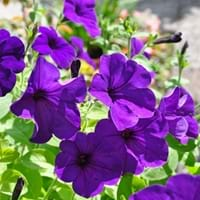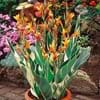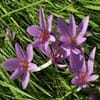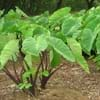Life Span
Perennial
Annual
Type
Bulb or Corm or Tuber
Flowering Plants, Shrubs
Origin
Latin America and the Caribbean, Central America, South America
Hybrid origin
Types
Canna Altensteinii, Canna Indica Purpurea
19
Habitat
Subtropical climates, Tropical regions, Warmer regions
Terrestrial
USDA Hardiness Zone
8-11
9-10
AHS Heat Zone
12-1
12 - 3
Sunset Zone
21,22
A1, A2, A3, H1, H2, 1a, 1b, 2a, 2b, 3a, 3b, 4, 5, 6, 7, 8, 9, 10, 11, 12, 13, 14, 15, 16, 17, 18, 19, 20, 21, 22, 23, 24
Habit
Upright/Erect
Prostrate/Trailing
Minimum Height
Not Available
Minimum Width
Not Available
Flower Color
White, Yellow, Red, Orange, Pink, Rose, Salmon
White, Blue, Purple, Pink, Light Pink, Hot Pink, Magenta, Lavender
Flower Color Modifier
Bicolor
Bicolor
Fruit Color
Green, Tan, Brown
Not Available
Leaf Color in Spring
Yellow, Red, Green, Purple, Gray Green, Dark Green, Burgundy
Green
Leaf Color in Summer
Light Green
Green
Leaf Color in Fall
Several shades of Green
Green
Leaf Color in Winter
Light Green
Light Green
Leaf Shape
Elliptic
Ovate
Plant Season
Spring, Summer, Fall
Spring, Summer, Fall
Sunlight
Full Sun, Partial Sun
Full Sun
Growth Rate
Fast
Very Fast
Type of Soil
Clay, Loam, Sand
Loam, Sand
The pH of Soil
Acidic, Neutral, Alkaline
Acidic, Neutral
Soil Drainage
Average
Well drained
Bloom Time
Indeterminate
Indeterminate
Tolerances
Drought
Drought
Where to Plant?
Container, Ground, Pot
Container, Ground, Pot
How to Plant?
From bulbs, Seedlings
Seedlings, Transplanting
Plant Maintenance
Medium
Medium
Watering Requirements
Keep the ground moist but not water-logged, Requires regular watering
Keep the ground moist but not water-logged, Requires regular watering, Requires watering in the growing season
In Summer
Lots of watering
Lots of watering
In Spring
Moderate
Moderate
In Winter
Average Water
Average Water
Soil pH
Acidic, Neutral, Alkaline
Neutral
Soil Type
Clay, Loam, Sand
Loamy, Sandy
Soil Drainage Capacity
Average
Well drained
Sun Exposure
Full Sun, Partial Sun
Full Sun, Partial shade
Pruning
Remove damaged leaves, Remove dead leaves
Cut or pinch the stems, Do not prune during shooting season, Remove dead or diseased plant parts, Remove deadheads
Fertilizers
All-Purpose Liquid Fertilizer
All-Purpose Liquid Fertilizer
Pests and Diseases
Red blotch
Red blotch
Plant Tolerance
Drought
Drought
Flower Petal Number
Single
Single
Foliage Texture
Bold
Medium
Foliage Sheen
Not Available
Matte
Attracts
Butterflies, Insects
Hummingbirds, Butterflies
Allergy
Not Available
Not Available
Aesthetic Uses
Beautification, Bouquets, Landscape Designing, Showy Purposes
Beautification, Bouquets, Showy Purposes
Beauty Benefits
Not Available
Not Available
Environmental Uses
Air purification
Air purification
Medicinal Uses
Diuretic
Not Available
Part of Plant Used
Flowers, Leaves, Root, Seeds
Flowers
Other Uses
Decoration Purposes, Showy Purposes, Used As Food, Used as Ornamental plant, Used in paper industry
Showy Purposes
Used As Indoor Plant
Yes
Yes
Used As Outdoor Plant
Yes
Yes
Garden Design
Bedding Plant, Container, Feature Plant, Foundation, Mixed Border, Tropical, Water Gardens
Hanging Basket
Botanical Name
CANNA
PETUNIA 'PAS3187'
Common Name
Canna, Canna Lily
Purple Wave Petunia, Spreading Petunia, Wave Purple Petunia
In Hindi
भंग लिली
Purple wave petunia
In German
Canna Lilie
Lila Welle Petunie
In French
Canna
Pétunia pourpre Vague
In Spanish
Canna lirio
Petunia púrpura Wave
In Greek
Canna κρίνος
Purple Wave πετούνια
In Portuguese
Canna
Onda roxa do petúnia
In Polish
Canna lilia
Purpurowy fali petunii
In Latin
Canna lilium
Purpura unda Petunia
Phylum
Embryophyta
Magnoliophyta
Class
Liliopsida
Magnoliopsida
Order
Zingiberales
Solanales
Family
Cannaceae
Solanaceae
Clade
Angiosperms, Commelinids, Monocots
Angiosperms, Asterids, Eudicots
Tribe
Not Available
Not Available
Subfamily
Not Available
Petunioideae
Season and Care of Canna and Purple Wave Petunia
Season and care of Canna and Purple Wave Petunia is important to know. While considering everything about Canna and Purple Wave Petunia Care, growing season is an essential factor. Canna season is Spring, Summer and Fall and Purple Wave Petunia season is Spring, Summer and Fall. The type of soil for Canna is Clay, Loam, Sand and for Purple Wave Petunia is Loam, Sand while the PH of soil for Canna is Acidic, Neutral, Alkaline and for Purple Wave Petunia is Acidic, Neutral.
Canna and Purple Wave Petunia Physical Information
Canna and Purple Wave Petunia physical information is very important for comparison. Canna height is Not Available and width Not Available whereas Purple Wave Petunia height is 10.20 cm and width 90.00 cm. The color specification of Canna and Purple Wave Petunia are as follows:
Canna flower color: White, Yellow, Red, Orange, Pink, Rose and Salmon
Canna leaf color: Yellow, Red, Green, Purple, Gray Green, Dark Green and Burgundy
Purple Wave Petunia flower color: White, Blue, Purple, Pink, Light Pink, Hot Pink, Magenta and Lavender
- Purple Wave Petunia leaf color: Green
Care of Canna and Purple Wave Petunia
Care of Canna and Purple Wave Petunia include pruning, fertilizers, watering etc. Canna pruning is done Remove damaged leaves and Remove dead leaves and Purple Wave Petunia pruning is done Cut or pinch the stems, Do not prune during shooting season, Remove dead or diseased plant parts and Remove deadheads. In summer Canna needs Lots of watering and in winter, it needs Average Water. Whereas, in summer Purple Wave Petunia needs Lots of watering and in winter, it needs Average Water.





